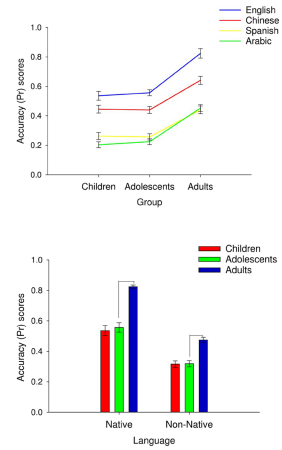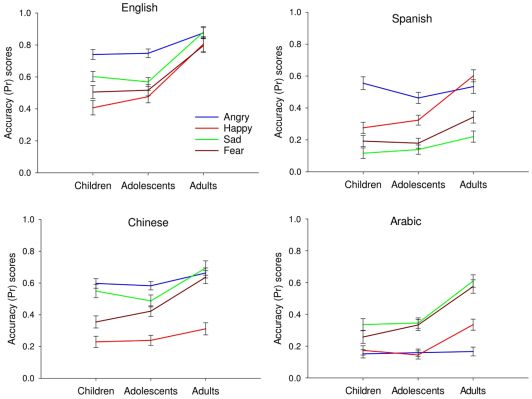|
|
|
|
|
注意你的语气:儿童能从声音中听懂情绪,无论是不是母语 |
|
|
论文标题:The development of cross-cultural recognition of vocal emotion during childhood and adolescence
期刊:Scientific Reports
作者:Georgia Chronaki, Michael Wigelsworth, Marc D. Pell & Sonja A. Kotz
发表时间: 2018/06/14
数字识别码: 10.1038/s41598-018-26889-1
原文链接:https://www.nature.com/articles/s41598-018-26889-1?utm_source=Other_website&utm_medium=Website_links&utm_content=RenLi-Nature-Scientific_Reports-Humanities_of_Multidisciplinary-China&utm_campaign=SCIREP_USG_rlp8212_vocal_sciencenet_article_June_3rd

《科学报告》发表的一项研究The development of cross-cultural recognition of vocal emotion during childhood and adolescence表明,儿童能够识别母语和外语人声中的情绪,不过在母语中的识别准确度更高。

图一:上图:不同年龄群体对每种语言的识别准确度;下图:青少年和成人对母语的语音情绪识别准确度提高了。
Chronak et al.
英国中央兰开夏大学的Georgia Chronaki及其同事让没有外语经验的57名儿童和22名年轻成年人完成一项语音情绪识别任务,其中涉及他们的母语(英语)和三种外语(西班牙语、中文和阿拉伯语),被试需要倾听演员说伪句,演员会通过语音表达愤怒、快乐、悲伤、恐惧和中性情绪。
作者发现尽管儿童能识别出外语中的情绪,但他们能更准确地识别母语中的语音情绪。相较于快乐和恐惧情绪,儿童能更准确地识别语音中的愤怒和悲伤的情绪。由于该任务涉及不包含实质内容的伪句,作者认为情感识别似乎是特异于语音而非语言方面。他们认为,虽然通过一个人的说话声音(音高、响度和节奏)而非所说内容来识别情绪的能力在儿时就已普遍存在,但是还有一种“内部优势”(in-group advantage)使人们能够基于社会文化规则,更准确地识别母语中的情绪。

图二:不同年龄群体对每种语言、情绪的识别准确度。
Chronak et al.
作者还表明,语音情绪识别从青春期到成年期有所增强,而在儿童期与青春期之间的增强程度不及前者。这表明青春期是情绪识别技能发展的重要时期。
摘要:Humans have an innate set of emotions recognised universally. However, emotion recognition also depends on socio-cultural rules. Although adults recognise vocal emotions universally, they identify emotions more accurately in their native language. We examined developmental trajectories of universal vocal emotion recognition in children. Eighty native English speakers completed a vocal emotion recognition task in their native language (English) and foreign languages (Spanish, Chinese, and Arabic) expressing anger, happiness, sadness, fear, and neutrality. Emotion recognition was compared across 8-to-10, 11-to-13-year-olds, and adults. Measures of behavioural and emotional problems were also taken. Results showed that although emotion recognition was above chance for all languages, native English speaking children were more accurate in recognising vocal emotions in their native language. There was a larger improvement in recognising vocal emotion from the native language during adolescence. Vocal anger recognition did not improve with age for the non-native languages. This is the first study to demonstrate universality of vocal emotion recognition in children whilst supporting an “in-group advantage” for more accurate recognition in the native language. Findings highlight the role of experience in emotion recognition, have implications for child development in modern multicultural societies and address important theoretical questions about the nature of emotions.
阅读论文全文请访问:https://www.nature.com/articles/s41598-018-26889-1?utm_source=Other_website&utm_medium=Website_links&utm_content=RenLi-Nature-Scientific_Reports-Humanities_of_Multidisciplinary-China&utm_campaign=SCIREP_USG_rlp8212_vocal_sciencenet_article_June_3rd
期刊介绍:Scientific Reports (https://www.nature.com/srep/) is an online, open access journal from the publishers of Nature. We publish scientifically valid primary research from all areas of the natural and clinical sciences.
The 2016 journal metrics for Scientific Reports are as follows:
•2-year impact factor: 4.259
•5-year impact factor: 4.847
•Immediacy index: 0.647
特别声明:本文转载仅仅是出于传播信息的需要,并不意味着代表本网站观点或证实其内容的真实性;如其他媒体、网站或个人从本网站转载使用,须保留本网站注明的“来源”,并自负版权等法律责任;作者如果不希望被转载或者联系转载稿费等事宜,请与我们接洽。